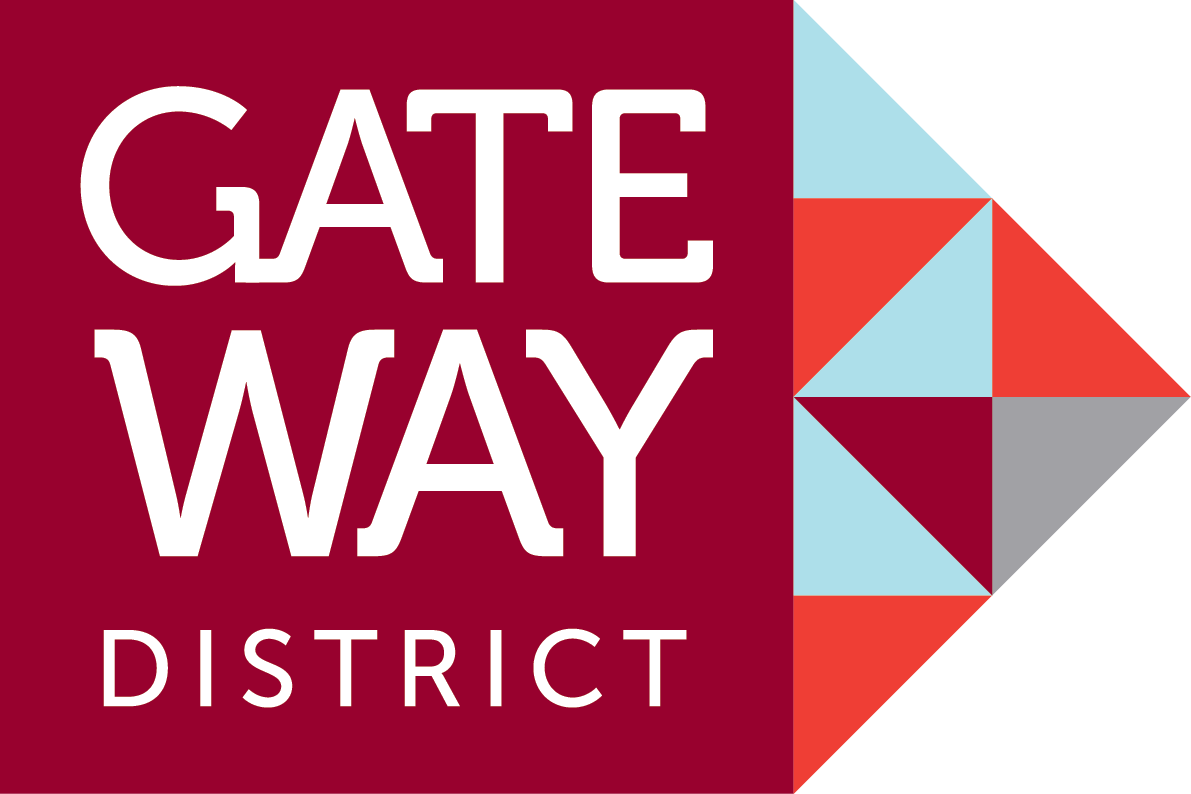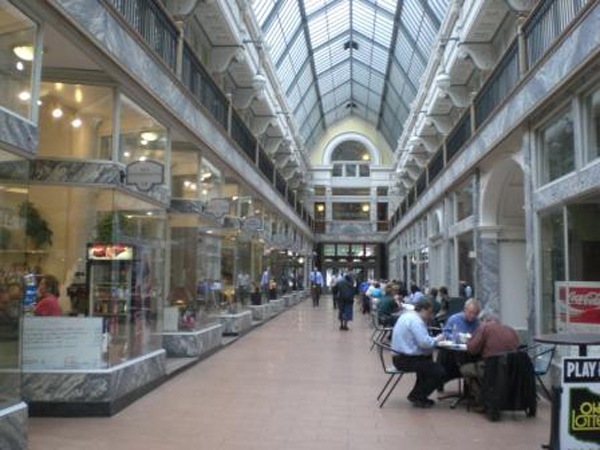Home to three National Register Historic Districts –
East 4th, Lower Prospect/Huron and the Lower Euclid Avenue District – the Gateway District also features three restored historic arcades, which are architecturally unparalleled in the United States.
1. The Arcade
The Arcade, probably one of the most photographed interiors in the nation, was built in 1890 as America’s first great indoor shopping center, which connects two grand thoroughfares, Euclid and Superior Avenues. The original design was considered so advanced and daring, no local firms bid on its construction. Thus, it was built by the Detroit Bridge Company. The glittering eight-story skylight soaring above five levels of shops, a food court and hotel rooms will dazzle you. Known as the “Crystal Palace” in 1890, the building’s 2011 restoration and reopening won the highest honor of the National Trust for Historic Preservation.
2. The Colonial and Euclid Arcades
The Colonial and Euclid Arcades are fully restored as the 5th Street Arcades, linking Euclid and Prospect Avenues with interior spaces housing a food court, barber shop, boutique shops, watch and jewelry shops, an artists’ co-op and the Baseball Heritage Museum.
The Colonial and Euclid Arcades share a history both intertwined and complex. Along Euclid, the western portion is comprised of the William and Rodgers Building (1898) and the Euclid Avenue entrance of the Euclid Arcade (1911). The eastern portion is comprised of the Kendall Building (c1887, altered 1929) and the Euclid Avenue entrance of the Colonial Hotel (1898), which fronts on Prospect Avenue.
Chronologically, the oldest part of this complex is the five-story Kendall Building at 520-532 Euclid. Though now refaced, it was built c 1887 and originally featured projecting bays. Next came the 6-story building at 510 Euclid; it was constructed in 1898 to house the William and Rodgers Department Store.
In 1898, the Colonial Hotel and Colonial Arcade were constructed. The hotel was built on Prospect directly behind the Kendall and William and Rodgers Buildings. This large hotel, now closed, was once a favorite of John D. Rockefeller’s until the rate increased from $1.00 to $2.00 a night. Visitors of today may be interested in staying at the Residence Inn by Marriott currently located at this site. The Residence Inn even has a John D. Rockefeller Lounge playing homage to the past.
The Colonial Arcade, which is surprisingly ornate in the interior, linked the hotel to the Kendall Building. The design of the two-story, sky-lit Colonial Arcade is clearly related to that of Cleveland’s famous The Arcade (1890). The architect of the Colonial Arcade and Hotel was George H. Smith, who also worked on The Arcade.
In 1910, financier John F. Rust hired architect Franz Warner to design an arcade linking the Colonial Hotel to the William and Rodgers Building. Thus was born the Euclid Arcade (1911). Unlike the other arcades, it is one story in height and features a barrel-vaulted ceiling with terra cotta walls and ceiling panels.
The last major change to the complex was the re-facing of the Kendall Building in 1929. The noted architectural firm of Walker and Weeks designed a new “granite terra-cotta” façade for the building’s tenant, the Schultze-United Company, a “5-cents to $1 store.” The company’s name was later removed from the building, and lighter-colored panels indicate its former location.
Today, the 5th Street Arcades is once again experiencing a redevelopment. Cumberland Development recently master-leased the space and has been busy rebranding the Arcades and filling vacancies with new retailers.
3. East 4th Street
Around the corner from the 5th Street Arcades, is East 4th Street, once known as the most notable outdoor link between Prospect and Euclid Avenues. East 4th was originally a narrow street with elm trees and houses of the New York apartment style. Formerly named Sheriff Street, this classic urban style street is both a National Register and Cleveland Landmark District and features a colorful history, many noteworthy buildings, and an exciting resurgent future.
The residential character of the street slowly transformed into a vibrant commercial center before the turn of the century. Among the many unique landmarks housed on the street, most famous was the Euclid Avenue Opera House, which was nationally known and Cleveland’s premier theatre from 1875 to 1920. Today one of the walls of the Euclid Avenue Opera House has been incorporated into Hilarities Comedy Club in the lower level of Pickwick and Frolic.
By the first half of the 1900’s, East 4th street boasted three national retailers: Woolworth’s, McCrory’s and S.S. Kresge’s, with the latter located on the corner of Euclid and East 4th in a building designed in Art-Deco style by the renowned architectural firm, Walker and Weeks.
The bustling street was home to many interesting tenants, including the original Sol Bergman’s (1893) in the Sincere Building; the Bonfoey Company (1894) in the Buckeye Building; and the Krause Costume Company, which moved to the street in 1883 and was located in the building of the same name. A number of restaurants, including the original Otto Moser’s, were established on the street to serve the theatrical trade.
East 4th Street fell into decline and was proposed for demolition in the 1980s. The area was saved by grassroots advocacy, achieving National Register and Local Landmarks status by 1988. The East 4th Street Local Development Corporation, founded by Bob Zimmer and other neighborhood stakeholders, evolved into the Historic Gateway Neighborhood Corporation of today.
East 4th Street now offers a plethora of dining options, bowling lanes, a comedy club and retail. Visitors will enjoy dining at Flannery’s Pub, the Greenhouse Tavern, Saigon and other well-known restaurants. Others may choose to relax over a cup of coffee at the Erie Island Coffee Company, or plan their next tour stop during a visit to the Positively Cleveland Visitors’ Center at the corner of East 4th Street and Euclid Avenue.








